Between travel, jet-lag, and getting caught up on audio and domestic activities, it's been a while since I've posted a comprehensive update on the Duelund-Altec Project (overview HERE).

Jazz Club Reduta in Prague in the Czech Republic.
A couple of posts ago (HERE) I reported on how much the "Stokowski" Altec's with their Duelund CAST tinned-copper crossovers (below) reminded me of the sound of the live jazz big band performance I heard at Jazz Club Reduta in Prague a few weeks back (above).

"Stokowski" Altec's with breadboard Duelund CAST tinned-copper crossovers.
So you might be wondering what the heck I'm talking about when I say the Altec's sounded a lot like the live big band performance at Reduta, so let me try to explain with a little more clarity for you.
First of all, in the Jazz Club Reduta, even though the big band was playing at normal volumes for a big band, which was about 110dB while cruising and higher than that on dynamic peaks, it never sounded harsh or perceptively overly loud, it just sounded like live music with a lot of natural presence. It was easy on the ears.
Part of that quality sound experience at the Jazz Club Reduta is because they had their reverb time and room treatments dialed in perfectly, so it gave the best of the big band's sound without ever making a misstep.
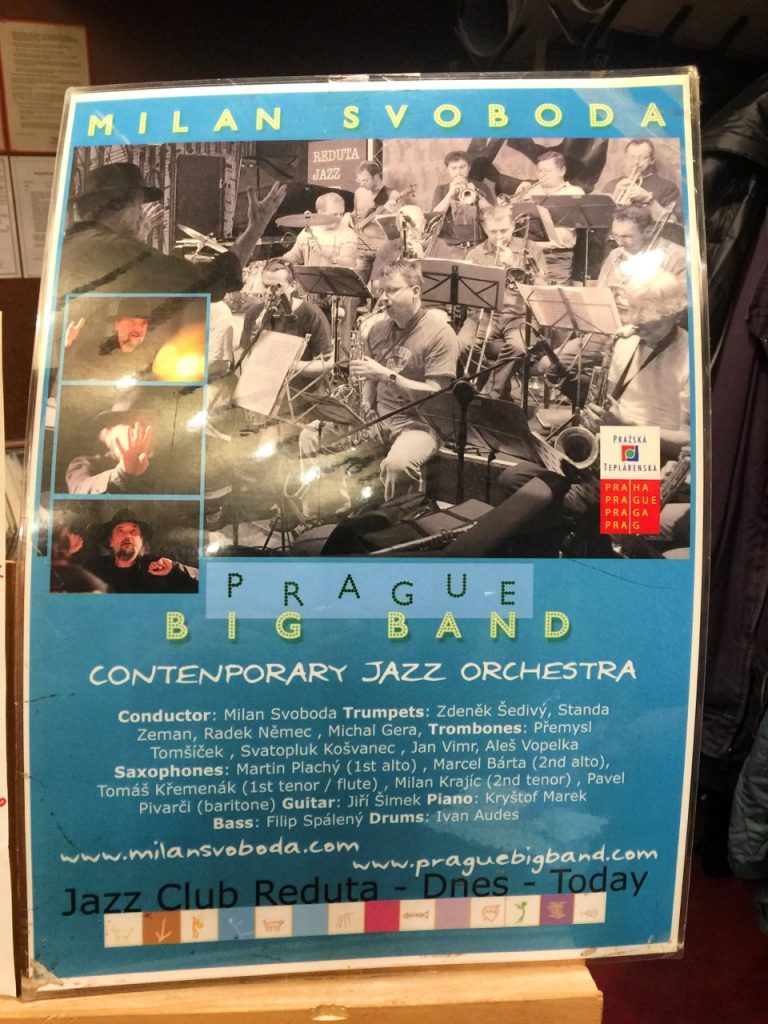
Three years ago when I was at Reduta, I noticed the same trait - it is a well treated and superb sounding venue for jazz, and whether I was listening to horns, vocals, upright bass, piano, guitar, a drum kit, etc., the live music being played in Reduta was shown at its best and sounded superbly natural and engaging.
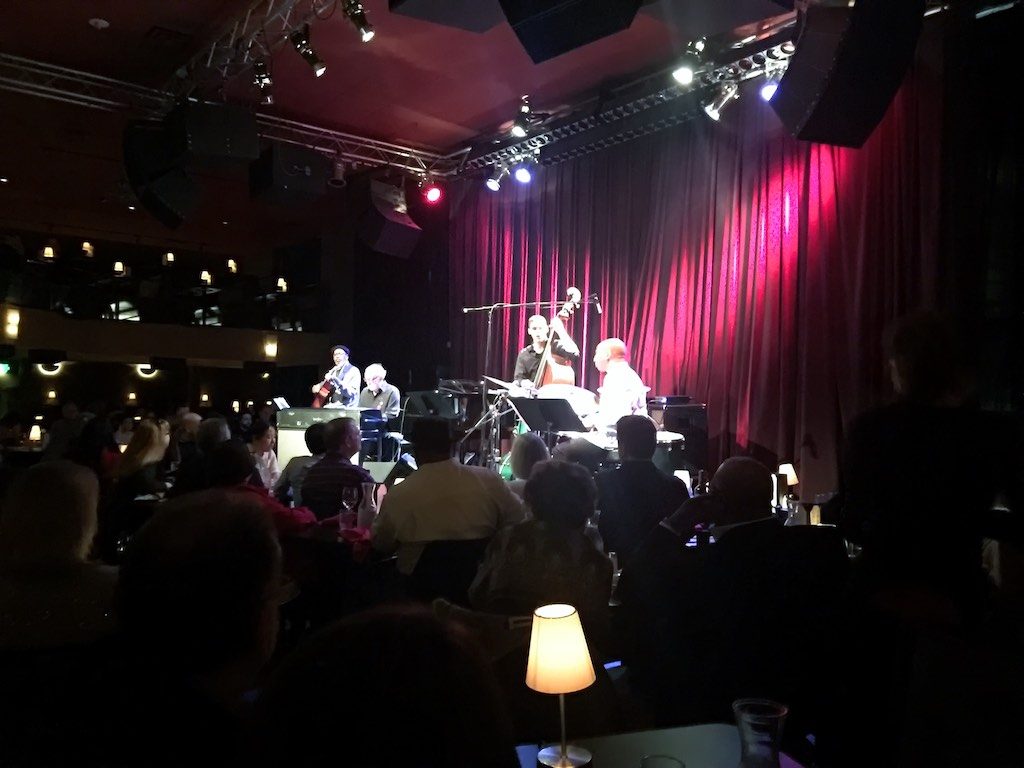
The Bob James Quartet live at Jazz Alley in Seattle.
Reduta in Prague is one of my favorite jazz clubs (below), followed closely by Jazz Alley in Seattle (above). However, the superb sound I've heard at Reduta has been more consistent than what I've heard at Jazz Alley, which can vary from great to just ok.
To be fair though, Reduta is a smaller and more intimate environment for listening to music, much like a large listening room might be, say one two or three times larger than my own listening/living room.
Jazz Alley is much larger, and no doubt is more challenging to get dialed in with all the different groups passing through.

Three years ago at Reduta.
Anyways, that "natural loudness ease" at Reduta is very much like what I hear from the "Stokowski" Altec's when equipped with the Duelund CAST tinned-copper crossovers.
Music can be played at naturally loud live-like levels appropriate to a given performance without sounding harsh, forward, or otherwise unpleasant. It just sounds very much like the natural sound of the live jazz music I heard in Reduta.
Other traits that the Duelund-ized "Stokowski" Altec's share with the live music I heard at Reduta was a very natural portrayal of tone, timbre, dynamics, presence, tempos, and melodies, for example.
Interestingly, the real time analysis (RTA) curve that I measured at Reduta - I know, I'm a nerd - also looked a lot like the RTA curve I get in my living room with the Altec's, although in Reduta there was more bass in the 20-32Hz range than I get in my listening/living room system with the Altec's. From about 32Hz on up to 16KHz the RTA of the two looked remarkably similar. At least in the music I play most often, there's very little above 16KHz, just like there was at Reduta.
So in a nutshell, the Duelund-ized "Stokowski" Altec's play at live-like levels very naturally, have live-like tone & timbre, excel at portraying motional elements like dynamics, tempo, melody, harmony, in a convincing and live-like way, with vocals & instruments having a lot of live-like presence and emotional impact, just like the live music at Reduta does.
But there's two other questions that beg answering, the first being how does Duelund-ized "Stokowski" Altec loudspeakers listening experience differ from that of live music, and how does it differ from a more typically voiced "audiophile-style" audio system you hear at audio shows or in people's homes?
Let's me talk about the first question, "How does Duelund-ized "Stokowski" Altec loudspeakers listening experience differ from live music?"
That's actually fairly easy to answer, as analog or digital sources are what I'm listening to through the Altec's instead of the live musicians from Reduta or another live setting.
Most notably, I hear the recording artifacts that are picked up by microphones in astonishing clarity during the recording sessions, which are present in live music with much less magnitude, if they are even audible at all. Those are attributes like exaggerated resolution, imaging, soundstage, and the "sense of space" generated in recordings, at least in some recordings, for example.
When you're listening to live music in Reduta you don't hear that same sense of a voluminous sense of spaciousness that you hear in some recordings, but rather you just hear the ambient environment of the jazz club.
Granted, that sense of space can sound pretty cool in an audiophile sort of way, but recordings generally present it as more pronounced than what you hear in most live venues. Unless you're really after the last degree of fidelity to live music, then you're probably ok with the portrayal of a little extra spaciousness in the playback of recorded music, as it tickles the imagination in a pleasurable way and perhaps makes up a bit for not being present at the live venue, even if it's not entirely accurate to live music.
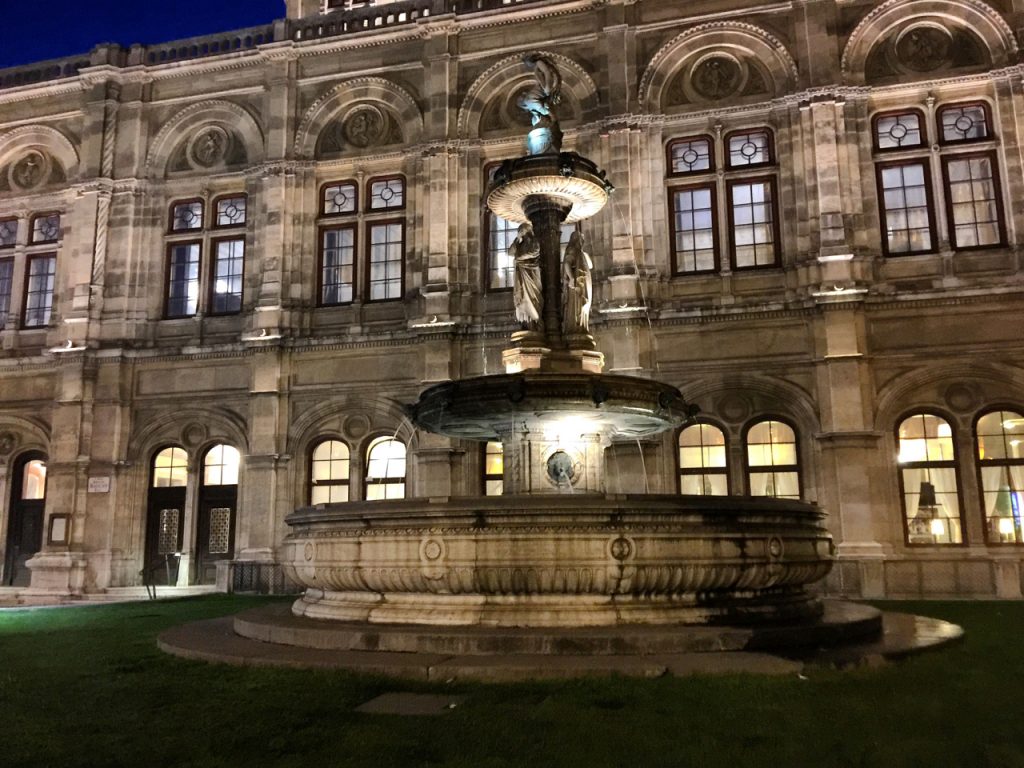
While in Vienna, Austria, a couple of weeks ago I went to the impressionist exhibition that was going on at the Albertina (I think that's where it was, but I don't remember for sure), rather than the Vienna State Opera House shown in the photo above, which was the photo I had handy. I'm a big fan of impressionist art, and it's is always a pleasure to see works by Monet, Van Gogh, and many others.
The recording artifacts we hear in recordings kind of reminds me a bit of impressionism, you know when you hear-see them it's not the real thing, but it evokes an emotional response, and in moderation provides a rather artful portrayal of the musical experience.
Back to the Altec's. With the Altec's you also hear a different sort of soundstage than you do with live performances, and you hear more image specificity as well.
Up to a certain size the soundstage sounds fairly natural and live-like with the Altec's, like it does live, but once it starts to get larger, like say in auditoriums, opera houses, reverberant old churches, or certainly stadium settings, the soundstage becomes a miniature version of the soundstage of a live performance. That's to be expected, not just with the Altec's, but with any stereo system I've ever heard, as you're just not going to produce a large venue in lifelike size in a typical home living room. Maybe that's part of the reason I love listening to jazz so much at home - other than obviously just loving jazz - as its "size" fits believably in my listening/living room.
Anyways, the recording process is capable of producing more distinct imaging than you can actually hear in live performances, and you can hear that with the Altec's in our live vs recorded music discussion because of that.
So again, that aspect falls a bit short of true fidelity to a live performance, but it does give recorded music a bit of extra presence through the Altec's than you can hear in most live music venues, and in the listening room that can be a pleasant effect if it's not overtly overdone, and for my taste the Altec's are about as perfect as I've heard in that regard.

"Stokowski" Altec's with breadboard Duelund CAST tinned-copper crossovers.
I mean let's face it, when your loudspeakers are 10-15 feet from your listening position, you're generally going to hear more presence than from performers who are 30 to 50 feet or more away in a live setting. If you listen in a near field setup, you're even going to hear more presence. Ok, so that's not true fidelity to the live performance, but when at home listening to recorded performances the effect can be nice if it is not overtly exaggerated.
Now let's tackle the second question, "How does the Duelund-ized "Stokowski" Altec loudspeakers listening experience differ from that of a more typically voiced "audiophile-style" audio system you hear at audio shows or in people's homes?"
Well, the Duelund-ized Altec's sound very natural playing at live-like levels, have live-like tone & timbre, excel at portraying motional elements like dynamics, tempo, melody, harmony in a convincing live-like way, with vocals & instruments having a lot of live-like presence and emotional impact, which I just don't hear in a lot of "audiophile-style" voiced systems.
Many "audiophile-style" voiced systems display a lot more of a noticeable unnatural "electronic signature" in their performance attributes than do the Duelund-ized Altec's, which sound very natural and life-like. Ken Ishiguro of Acoustic Revive, for example, is particularly sensitive to these sorts of distortions and works tirelessly to eradicate them in his accessories, and I thank him for that noble effort.
If you listen to an audiophile-style system most of the time, and you were to sit down and listen to these Duelund-ized Altec's, I think the first thing you'd say is that they have a gorgeous, vivid, and life-like midrange, and superb dynamics, that gives you goosebumps all over, and the second thing you might say is "Where did the highs and lows go?"

The Altec's 803B low-frequency drivers go down convincingly to the 30's, but they're not going to plumb the frequency depths like my Westminster's can, for example. This will bother some more than others, but I'm fine with it, as most of the music I listen to works well with that depth of bass extension. If I want more I'll get out the West's or add a sub!
The Altec's have very smooth and natural high-frequencies, and you don't hear that unnatural sheen and forwardness in the highs like you do with a lot of loudspeakers.
The Altec's are more the girlfriend whispering in your ear than the screechy public address system blaring at you.
I really like the "Stokowski" Altec's presentation of the high-frequencies, but some will be troubled that the highs aren't more obvious and forward sounding, like what you hear in a typical audiophile loudspeaker, a sound that many have grown accustomed to.
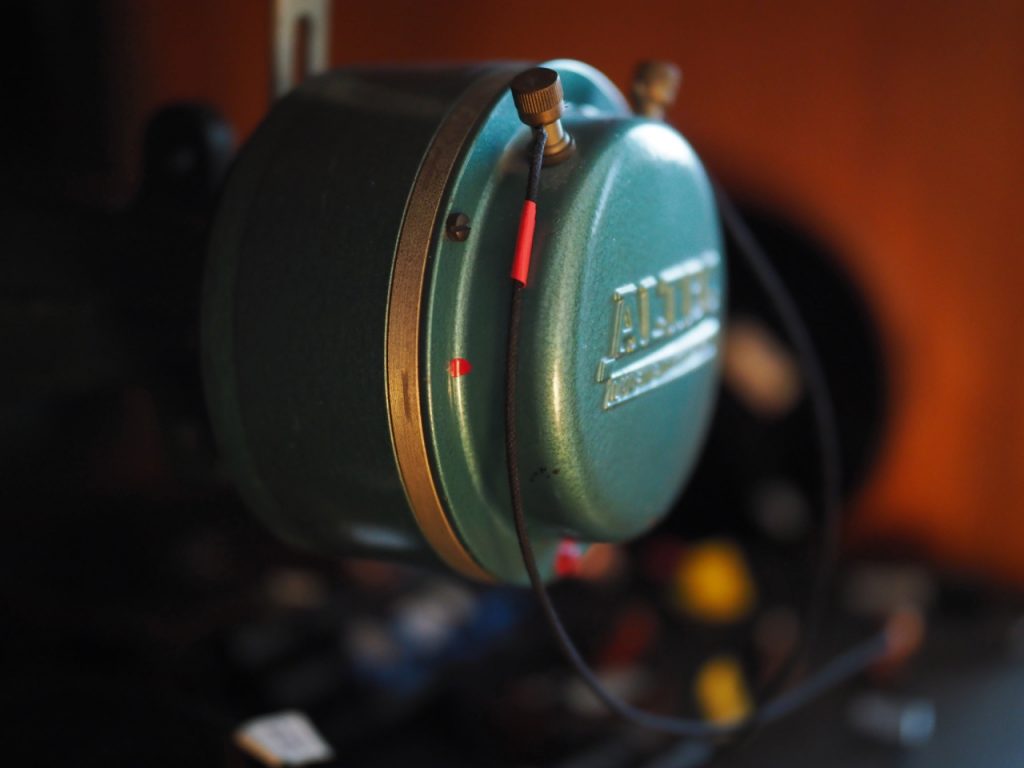
DCA20GA on the Altec's 804A high-frequency compression drivers.
The 804A Altec high-frequency compression drivers are rated for 500 to 22000 cycles, so if it's on the recording in that range you'll hear it, but I suspect the highs are down a bit with the Hiraga-style crossovers, but I don't know for sure, or by how much.
I suppose I need to do some in-room frequency sweeps to figure that out, but I haven't got around to that yet, mostly because the "Stokowski" Altec's with their Duelund CAST tinned-copper crossovers sound so bloody musical, and appropriately life-like and engaging the way they are now, that I haven't really cared about figuring that aspect out exactly. I know, that's heresy!
Ok, so what's the take away message from all that I said above? The "Stokowski" Altec's with their Duelund CAST tinned-copper crossovers sound more like live music to me than any other loudspeaker I've heard, period. They do add a little extra vividness, spaciousness, imaging, and soundstaging effects from recordings than you would hear in live music, as you would expect, but even at that they have that aspect balanced better than any other loudspeaker I am familiar with.
The "Stokowski" Altec's with their Duelund CAST tinned-copper crossovers also sound more like live music to me than any audiophile loudspeaker I've heard, regardless of the price. That's pretty amazing given they are vintage loudspeakers, albeit with truly incredible crossovers.
To be fair, these "Stokowski" Altec's with their Duelund CAST tinned-copper crossover are not a fair comparison to most commercial loudspeakers, as they are both custom loudspeakers and crossovers, and you can't buy them.
Ok, if you offered me silly money for them I would think about selling them, but probably not for long, because I really love them and I want to keep them forever! If you are really nice to me I might consider leaving them to you in my will. So there.
Seriously, I do think you could build pretty close analogs of the Duelund-Altec Project "Stokowski" Altec's for somewhere between $30K-$60K USD, but that's a big WAG, so I'll try to come up with a more accurate number for the feature article in Positive Feedback.
Next Steps
Ok, you already get that I'm thrilled with the performance boost the Duelund CAST tinned-copper crossovers give the "Stokowski" Altec loudspeakers, as I've been raving about them for months now as I've been getting them dialed in, and at least for my tastes and priorities, they're truly in rarefied territory.
I ordered custom plinths to mount the Duelund CAST Sn-Cu components to, and I'll be using the beautiful Oropel terminal strips to connect everything together.

It'll be two or three weeks before the Amish woodworkers that are building the plinths finish them up and ship them to me.
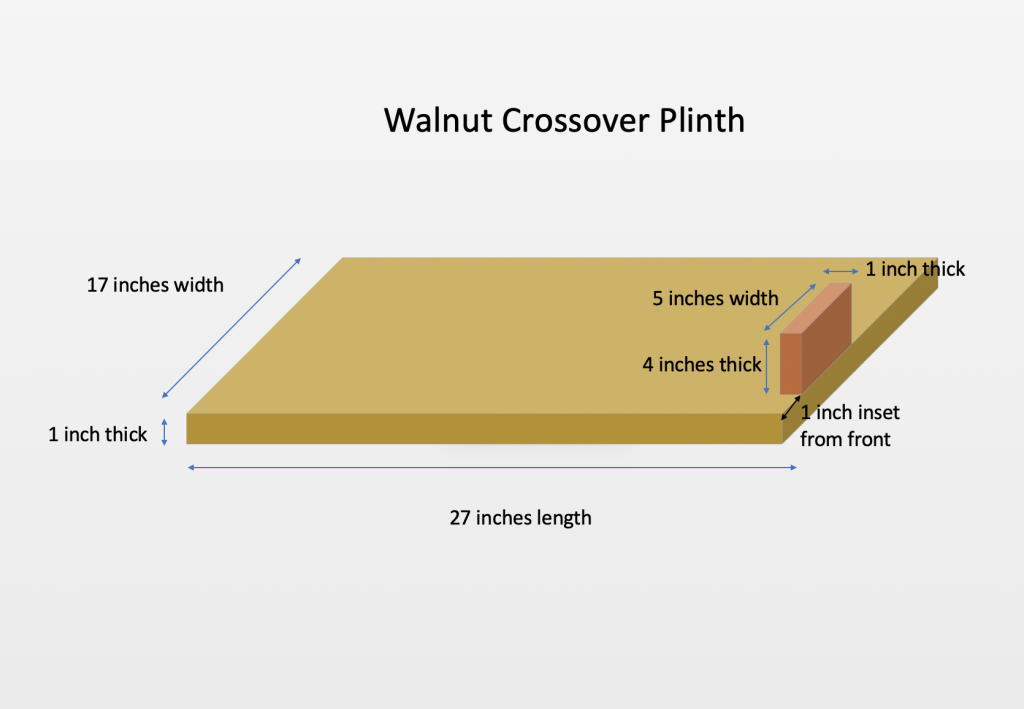
I went for a really simple, but I think tasteful, plinth design. Solid walnut. I like the natural tonality you get from wood.
The plinths are sized to fit inside the Altec's high-frequency cabinet, or alternately to be placed on the floor beside or behind the loudspeakers. Also, the plinths really need to be at least this size to position the Duelund CAST components in an orientation where you don't get any unwanted overlapping inductor effects. I could have made it a little smaller I suppose, but not by much, as there's a lot of Duelund CAST components there!
The walnut block you see at the right front corner of the plinth is to mount the Duelund CAST tinned-copper air-core inductor that is in that position in a vertical orientation, as in the photo below of the breadboarded crossover.
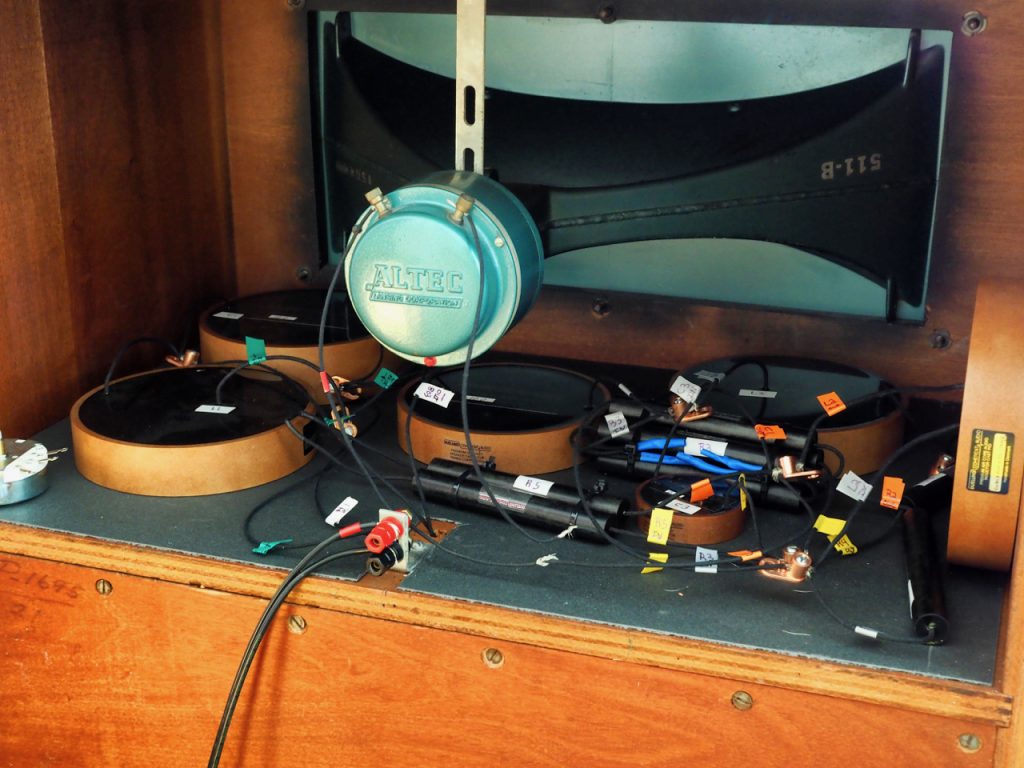
Duelund CAST Sn-Cu crossover breadboard in the Stokowski Altec.
When I get the plinths I'll place them in the high-frequency horn cabinets of the Altec's, and figure out how much room I really have to work with for isolation feet, which will dictate which ones I choose. The main consideration will be how much height I can add with isolation feet without getting in the way of the Altec 511B high-frequency horn.
If you guys have any favorite isolation feet be sure to let me know so I can check them out, but at this point the plan is probably to use the same ones I use on my turntable plinths, the Stillpoints. I hear good things about the Track Audio and IsoAcoustics isolators too, but I haven't ever had the opportunity to see them in person or hear them in action.
I still want to try the Duelund 600V DCA20GA tinned-copper wire in place of the original Duelund DCA20GA tinned-copper wire I am currently using on the 804A Altec high-frequency compression drivers, and I'll report on that experiment before too long.
So things are winding up pretty quickly now with the Duelund-Altec Project, and it's going to be exciting to see - and hear - it all come together!
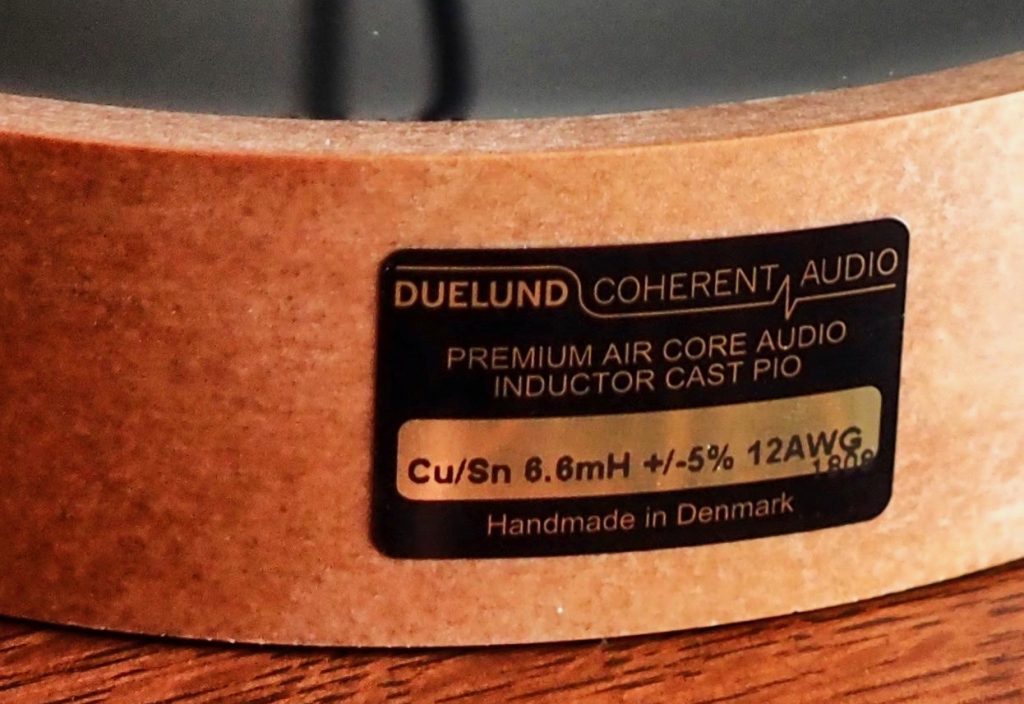
The leads are Duelund DCA12GA tinned-copper wire on the CAST Air Core Inductors.
As always, thanks for stopping by, and may the tone be with you!



























